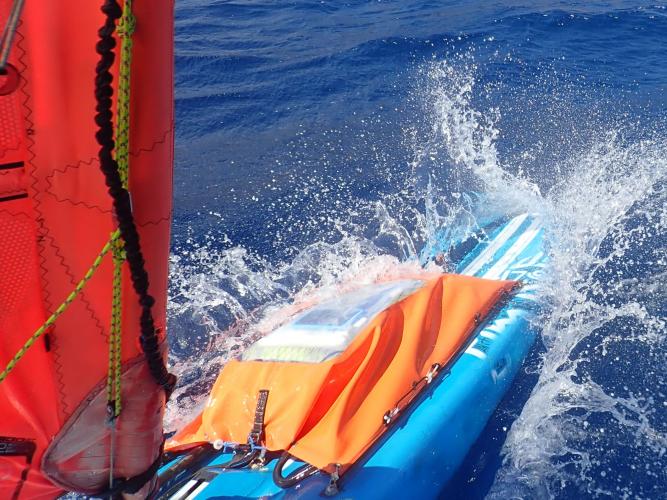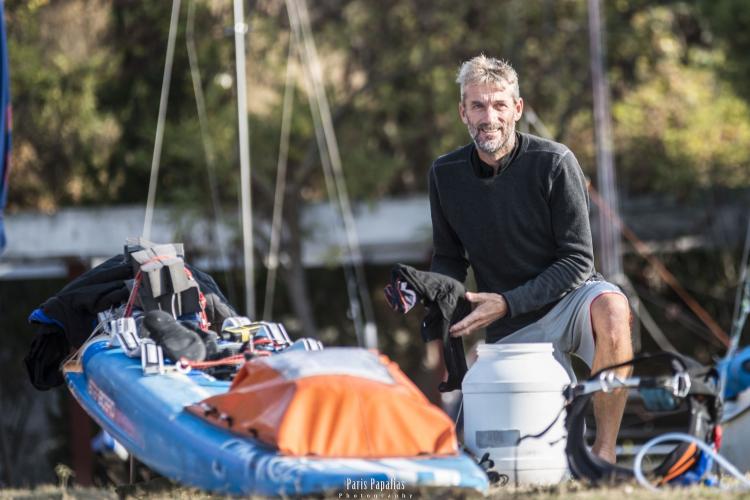Windsurf Expedition Board and Sail
After 2 years sailing and tweaking, this is how my expedition gear is set up on the final days (sniff) of the maritime stage. Each section is followed by pictures that explain each point. Click on images for captions.
Sail
Adjustable outhaul and downhaul
Standard setup as per for competition use. Note that repeated downhaul adjustment over a mast extension collar tends to shred the sail. To prevent this - from sail 2 onwards - I used an extension sleeve made from a broken mast bottom section (allowing a lower collar and snag free downhaul adjustment)
Clew stabilisation system (side lines)
I sail with the boom set too long, allowing scope to fully tension the downhaul and outhaul as conditions require. With the sail set for light winds, this allows an unpleasantly floppy connection (big gap) between clew and end of boom. My solution to this problem are side lines: rings on the boom arms with loops to the clew that limit the possible movement range. On low outhaul settings (big gap to end of boom and normally wobbly) the side lines (working as a pair) hold the clew tight and central. With outhaul pulled tight the side lines fall loose and do nothing.
Rigging the system is simple: tension the sail, poke the side lines through the clew eyelet, attach split rings to prevent the lines pulling back through, detension sail.
Outhaul shackle
Makes rigging and derigging an adjustable outhaul system really easy. A captive shackle is best as it will remain attached to the outhaul loop even when open. You can simply drill a normal shackle and attach a line to make it captive. The shackle pin should be the twist lock type that can’t fall out and be lost.
Uphaul handle
Much more comfortable on the front hand than holding the uphaul. A lower front hand is also much less tiring. In cold conditions a lower front hand is warmer.
GPS holder
Holds GPS in a readable position. GPS is secured at all times on adjustable outhaul elastic and can change side of boom as required (simply slide it round to the other side of the boom, no problem if you drop it because it is secured). The elastic loops on the harness lines use bits of camber inducer roller: perfect adjustable loop with no moving parts, no metal, tiny weight. This system would work fine for a phone in a pouch too.
Tack Strap
The Severne GT doesn't come with a tack strap, but with a loop of formuline through the downhaul pulley webbings it is simple enough to get the same effect...
Expedition Board
Leash
Multi-purpose for securing things, and in wilder conditions for connecting board and sail in case of separation. Two stainless clips with breaking strain well over 100 kilos. The elastic is only 6mm which is too light weight. 8mm would be more appropriate! The clips are a bit heavy but are reliable and easy to use.
Footstrap loops
On all footstrap screws. Lightweight and secure fixing for almost no weight cost. You can’t have too many loops…
Bow storage
My solution worked but is far from optimal. Drybags when held underwater are never truly dry. There is too much dead space here where water can pool. Next one will be better! This shape also drives the board further under when in a nose-dive. It needs to be a cutting vee that pushes water to the sides. Looking forward to testing out ideas for the next one. Solar charger goes in the pocket here, but it didn’t work great, and the weight of a battery isn’t welcome on the bow.
Barrel carrier
As used round Britain. It works well. Perhaps a twin rail system to support the barrel and allow it to be fixed lower. Weight over the tail is ideal, but high centre of gravity is a problem. Fin bolts, footstrap fixings, and daggerboard all help secure the barrel. Only 60nm to go and it hasn’t fallen off yet. Next one in carbon! There is a fishing line in there too.
Spare UJ
Accessible in case of emergency. I am on original tendon joint and have had no UJ breakages.
Water
Heavy but necessary. Best carried towards the stern.
 bow storage!
bow storage!
Paddling solution
Paddling has been essential. With a paddling solution to get you out of the shit you can go far...
Blocks
These are bricks cut from a bodyboard, stuck together, and with bits of batten tube inside like an internal kebab stick. The attachment points are looped around the internal tubes so can’t pull out. These are very light weight.
Holes in the wings of the board allow a quick assembly/release solution for the block retention elastics. When planing a spout of water comes up through each hole, so there is a clear performance cost to the holes (unless taped/plugged when not in use).
Stowed, the blocks are quite neat.
Set up for paddling mode the blocks form a bridge upon which the boom rests. The system is quick to set up / disassemble. The elastics are quick release adjustable length (sail ties). The final part of the loop is thinner for less drag in the water. When sailing the additional drag is noticeable from about F2/3 so it is best to stow properly when there is wind.
Sail stabilisation lines
The sail will not stay in position unless secured. It must be possible and preferably easy to transition to paddling (and back to sailing) whilst at sea. It must be possible to quick release the sail (for example when wind suddenly arrives, or when trying to make a no wind landing in surf). My solution uses a line each side: one attached to the boom that pulls the boom directly down by the back footstrap, and a second line that loops around the adjustable downhaul. Both loops are tensioned and cleated on a (lobster pot closure) hook (with cleats) that simply twists into the downhaul lines of the mast base. The hook and cleats retract into the bow storage section during normal sailing.
Paddle
Anything fragile on the deck get jumped on and breaks itself and the deck. My one-piece paddle snapped. My wooden fix snapped. My aluminium paddle hybrid fix also snapped. Then I found some thick wall carbon tube for the extension: being carbon is can withstand the repeated flex, and being thick it supports the outer tube when jumped on. Perfect - and this is the successful fix that has been with me since Spain’s Atlantic coast.
It pays to really think hard about how things are attached to the deck. On occasion I have seen that there have been failed attempts to remove the paddle when I have left the board alone. I have it set up to quick release but it requires a bit of thinking to work out how!
My setup is far from optimal but hopefully my experience with what works and what doesn't will help those looking to explore by raceboard. As windsurfers we have a privileged opportunity to see places and live experiences unavailable to others. Incredible journeys await. Be safe and sail far.

